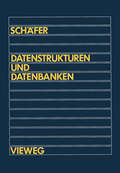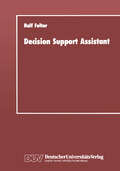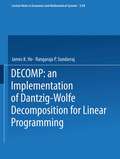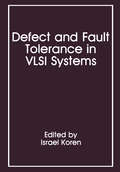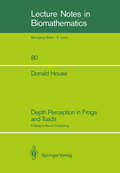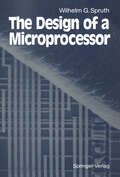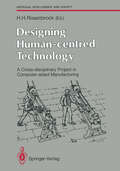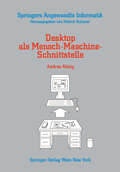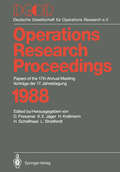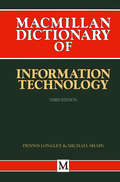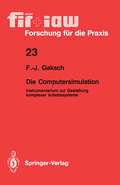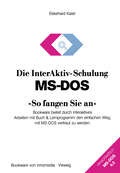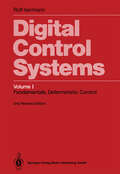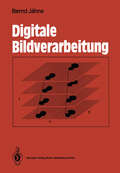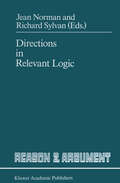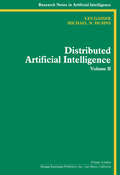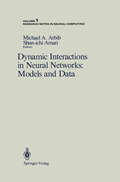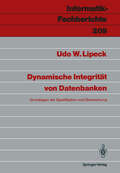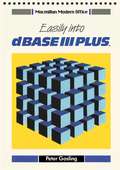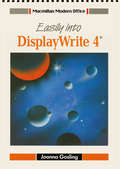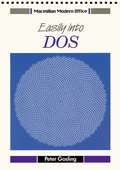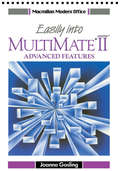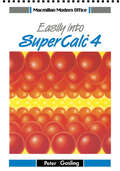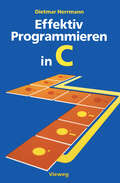- Table View
- List View
Decision Support Assistant: Ein Konzept für ein Software-Verwaltungssystem, mit dem vorhandene Software effizient zu leistungsfähigen Entscheidungsunterstützenden Systemen zusammengestellt werden kann
by Ralf FelterDECOMP: an Implementation of Dantzig-Wolfe Decomposition for Linear Programming (Lecture Notes in Economics and Mathematical Systems #338)
by James K. Ho Rangaraja P. SundarrajFor linear optimization models that can be formulated as linear programs with the block-angular structure, i.e. independent subproblems with coupling constraints, the Dantzig-Wolfe decomposition principle provides an elegant framework of solution algorithms as well as economic interpretation. This monograph is the complete documentation of DECOMP: a robust implementation of the Dantzig-Wolfe decomposition method in FORTRAN. The code can serve as a very convenient starting point for further investigation, both computational and economic, of parallelism in large-scale systems. It can also be used as supplemental material in a second course in linear programming, computational mathematical programming, or large-scale systems.
Defect and Fault Tolerance in VLSI Systems: Volume 1
by Israel KorenThis book contains an edited selection of papers presented at the International Workshop on Defect and Fault Tolerance in VLSI Systems held October 6-7, 1988 in Springfield, Massachusetts. Our thanks go to all the contributors and especially the members of the program committee for the difficult and time-consuming work involved in selecting the papers that were presented in the workshop and reviewing the papers included in this book. Thanks are also due to the IEEE Computer Society (in particular, the Technical Committee on Fault-Tolerant Computing and the Technical Committee on VLSI) and the University of Massachusetts at Amherst for sponsoring the workshop, and to the National Science Foundation for supporting (under grant number MIP-8803418) the keynote address and the distribution of this book to all workshop attendees. The objective of the workshop was to bring t. ogether researchers and practition ers from both industry and academia in the field of defect tolerance and yield en ha. ncement in VLSI to discuss their mutual interests in defect-tolerant architectures and models for integrated circuit defects, faults, and yield. Progress in this area was slowed down by the proprietary nature of yield-related data, and by the lack of appropriate forums for disseminating such information. The goal of this workshop was therefore to provide a forum for a dialogue and exchange of views. A follow-up workshop in October 1989, with C. H. Stapper from IBM and V. K. Jain from the University of South Florida as general co-chairmen, is being organized.
Depth Perception in Frogs and Toads: A Study in Neural Computing (Lecture Notes in Biomathematics #80)
by Donald HouseDepth Perception in Frogs and Toads provides a comprehensive exploration of the phenomenon of depth perception in frogs and toads, as seen from a neuro-computational point of view. Perhaps the most important feature of the book is the development and presentation of two neurally realizable depth perception algorithms that utilize both monocular and binocular depth cues in a cooperative fashion. One of these algorithms is specialized for computation of depth maps for navigation, and the other for the selection and localization of a single prey for prey catching. The book is also unique in that it thoroughly reviews the known neuroanatomical, neurophysiological and behavioral data, and then synthesizes, organizes and interprets that information to explain a complex sensory-motor task. The book will be of special interest to that segment of the neural computing community interested in understanding natural neurocomputational structures, particularly to those working in perception and sensory-motor coordination. It will also be of interest to neuroscientists interested in exploring the complex interactions between the neural substrates that underly perception and behavior.
The Design of a Microprocessor
by Wilhelm G. SpruthThis text has been produced for the benefit of students in computer and infor mation science and for experts involved in the design of microprocessors. It deals with the design of complex VLSI chips, specifically of microprocessor chip sets. The aim is on the one hand to provide an overview of the state of the art, and on the other hand to describe specific design know-how. The depth of detail presented goes considerably beyond the level of information usually found in computer science text books. The rapidly developing discipline of designing complex VLSI chips, especially microprocessors, requires a significant extension of the state of the art. We are observing the genesis of a new engineering discipline, the design and realization of very complex logical structures, and we are obviously only at the beginning. This discipline is still young and immature, alternate concepts are still evolving, and "the best way to do it" is still being explored. Therefore it is not yet possible to describe the different methods in use and to evaluate them. However, the economic impact is significant today, and the heavy investment that companies in the USA, the Far East, and in Europe, are making in gener ating VLSI design competence is a testimony to the importance this field is expected to have in the future. Staying competitive requires mastering and extending this competence.
Designing Human-centred Technology: A Cross-disciplinary Project in Computer-aided Manufacturing (Human-centred Systems)
by Howard H. RosenbrockThis second book in our series Artificial Intelligence and Society explores the issues involved in the design and application of human-centred systems in the manufacturing area. At first glance it may appear that a book on this topic is somewhat peripheral to the main concerns of the series. In fact, although starting from an engineering perspective, the book addresses some of the pivotal issues confronting those who apply new technology in general and artificial intelligence (AI) systems in particular. Above all, the book invites us to consider whether the present applications of technology are such as to make the best use of human skill and ingenuity and at the same time provide for realistic and economically sustainable systems design solutions. To do so it is necessary to provide systems which support the skill, and are amenable to the cultures, of the areas of application in question. In a philosophical sense it means providing tools to support skills rather than machines which replace them, to use Heidegger's distinction. The book gives an authoritative account of the University of Manchester Institute of Science and Technology (UMIST) tradition of human-centredness and provides a participatory design ap proach which focuses on collaborative learning and enhancement and creation of new skills. It also argues that collaboration should be supported by institutions through the creation of supportive infrastructures and research environments. It emphasises the optimisation of practical knowledge with the help of scientific knowledge and rejects the alternative.
Desktop als Mensch-Maschine-Schnittstelle (Springers Angewandte Informatik)
by Andrea KönigDie Mensch-Maschine-Schnittstelle erlangt immer größere Bedeutung im Hinblick auf schnelle und ergonomische Kommunikation zwischen Mensch und Rechner. Mit graphischen Hilfsmitteln sowie leistungsfähigen Eingabemedien, wie Maus und Touch-Screen, können Dialogtechniken realisiert werden, die dem Interaktionsverhalten des Benutzers immer mehr entgegenkommen. Im Zusammenhang damit ist der Begriff Desktop (Schreibtisch) bekannt geworden, wo alltägliche Tätigkeiten der Büroarbeit mit der Benutzeroberfläche eines Systems imitiert werden. Ziel des Buches ist es, dem Leser einen Überblick über die verschiedenen Desktop-Systeme zu geben. Die wichtigsten Interaktionstechniken werden miteinander verglichen und bezüglich Ergonomie und Flexibilität beurteilt. Auch psychologische Aspekte werden berücksichtigt. Es werden beim Leser keine technischen Kenntnisse vorausgesetzt.
DGOR: Papers of the 17th Annual Meeting / Vorträge der 17. Jahrestagung 1988 (Operations Research Proceedings #1988)
by Dieter Pressmar Kurt E. Jäger Hermann Krallmann Helmut Schellhaas Lothar StreitferdtDictionary of Information Technology (Dictionary Series)
A dictionary of information technology containing over 7800 entries, which attempts to explain data processing, communications, office systems, information systems, micro-electronics, graphics, printing and consumer electronics. Over 150 diagrams accompany the text for further clarity.
Die Computersimulation: Instrumentarium zur Gestaltung komplexer Arbeitssysteme (fir+iaw Forschung für die Praxis #23)
by Franz-Josef GakschAm Fallbeispiel einer Verteiler-LKW-Tätigkeit wird eine Computersimulation als arbeitswissenschaftliches Instrumentarium zur Beurteilung von Belastungen und Beanspruchungen bei der Fahrzeugführung vorgestellt. Hierzu werden Merkmale der Arbeitsumgebung in Form von Stressoren dargestellt, während die personalen Bedingungen durch Schlüsselqualifikationen abgebildet werden, wodurch die Aufdeckung von Wirkungszusammenhängen ermöglicht wird. Für verschiedene Versuchsbedingungen können unterschiedliche Ausprägungen der Schlüsselqualifikationen nachgewiesen werden. Anhand einer vergleichenden Untersuchung der unterschiedlichen Wirkung von Schalt- bzw. Automatikgetriebe auf den Fahrer wird die Eignung der beschriebenen Simulation demonstriert.
Die InterAktiv-Schulung MS-DOS »So fangen Sie an«: Bookware bietet durch interaktives Arbeiten mit Buch & Lernprogramm den einfachen Weg, mit MS-DOS vertraut zu werden
by Ekkehard Kaier23 1.2.3 MS-DOS von der Festplatte starten Urn von der Festplatte aus zu booten, geht man in vier Schritten vor: 1. Standardlaufwerk A: entriegeln. 2. Angeschlossene Gerate einschalten (z.B. Drucker). 3. PC einschalten. 4. MS-DOS wird von Festplattenlaufwerk C: gebootet. Nach dem Einschaiten des PCs wird stets im Standardlaufwerk A: gesucht. Befindet sich darin keine Diskette bzw. ist das Laufwerk entriegelt, wird automatisch auf der Festplatte von Laufwerk C: nach dem Bootprogramm gesucht. Andernfalls gibt MS-DOS z.B. die folgende Fehlermeldung aus (Abkurzung DSKT fUr Diskette): Ke;ne SYS-DISKT oder fehlerhafte DSKT Austauschen e;ne Taste betat;gen Nach AbschluB des Bootvorgangs sind wiederum zwei Moglichkeiten denkbar: MS-DOS meldet z.B. sich mit "C>" als seinem Prompt. MS-DOS aktiviert automatisch ein anderes Programm, das sich dann mit seinem Prompt bzw. seiner Benutzeroberflache meldet. 1.3 Zusammenfassung In Abschnitt 1 haben Sie die Grundlagen des Betriebssystems MS-DOS kennengelernt. Sie wissen nun: Was die Begriffe Hardware und Software bedeuten. Wie das Betriebssystem als Systemsoftware einzuordnen ist. Welchen Zweck MS-DOS als Betriebssystem hat. Was man unter Booten bzw. Bootlaufwerk versteht. Welcher Bildschirmdialog sich beim Booten entwickeln kann. Wie man MS-DOS von einer Diskette startet.
Digital Control Systems: Volume 1: Fundamentals, Deterministic Control
by Rolf IsermannThis well-known book is an introduction to the field of digital, sampled-data control. It treats the field in depth and can be used for courses and for self study. The second edition has been completely revised and expanded with new results. The work now appears in two volumes, with Volume 2 to be published in 1989. The volumes form a unit and take the reader systematically from fundamentals to problems of real applications. The work is directed towards students of electrical and mechanical engineering, computer science (especially with a specialization on automation and control engineering), and other fields like biology, economics, space mathematics and physics. It is also directed to engineers and scientists concerned with solving concrete problems.
Digitale Bildverarbeitung
by Bernd JähneDiese praxisorientierte Einführung baut auf Prinzipien und mathematischen Methoden auf, die aus Naturwissenschaft und Technik bekannt sind; es werden keine speziellen Kenntnisse der Informatik vorausgesetzt. Das Buch führt von den Grundlagen zu den modernen Konzepten der Bildverarbeitung. Es behandelt: Bildaufnahme; Bildverbesserung; Lineare und nichtlineare Filteroperationen zur Erkennung von Kanten, lokaler Orientierung und Textur; Pyramiden; Segmentierung und Klassifizierung. Weitere Kapitel befassen sich mit der Rekonstruktion dreidimensionaler Bilder aus Projektionen und mit Gradienten-, Korrelations- und Filterverfahren zur Analyse von Bewegungen in Bildfolgen. Praktische Beispiele aus zahlreichen Fachgebieten illustrieren - zum Teil in Farbe - die Darstellung. Sie zeigen dem Leser, daß selbst komplexe Aufgaben mit kostengünstigen Bildverarbeitungssystemen auf der Basis eines Personalcomputers durchführbar sind. Das Buch wendet sich an Studenten, Naturwissenschaftler und Ingenieure, die sich mit digitaler Bildverarbeitung und ihrer praktischen Anwendungsmöglichkeit in Wissenschaft und Technik vertraut machen wollen.
Directions in Relevant Logic (Reason and Argument #1)
by J. Norman R. SylvanRelevance logics came of age with the one and only International Conference on relevant logics in 1974. They did not however become accepted, or easy to promulgate. In March 1981 we received most of the typescript of IN MEMORIAM: ALAN ROSS ANDERSON Proceedings of the International Conference of Relevant Logic from the original editors, Kenneth W. Collier, Ann Gasper and Robert G. Wolf of Southern Illinois University. 1 They had, most unfortunately, failed to find a publisher - not, it appears, because of overall lack of merit of the essays, but because of the expense of producing the collection, lack of institutional subsidization, and doubts of publishers as to whether an expensive collection of essays on such an esoteric, not to say deviant, subject would sell. We thought that the collection of essays was still (even after more than six years in the publishing trade limbo) well worth publishing, that the subject would remain undeservedly esoteric in North America while work on it could not find publishers (it is not so esoteric in academic circles in Continental Europe, Latin America and the Antipodes) and, quite important, that we could get the collection published, and furthermore, by resorting to local means, published comparatively cheaply. It is indeed no ordinary collection. It contains work by pioneers of the main types of broadly relevant systems, and by several of the most innovative non-classical logicians of the present flourishing logical period. We have slowly re-edited and reorganised the collection and made it camera-ready.
Distributed Artificial Intelligence: Volume II
by Robin Gasser Michael N. HuhnsDistributed Artificial Intelligence
Dynamic Interactions in Neural Networks: Models and Data (Research Notes in Neural Computing #1)
by Michael A. Arbib Amari Shun-IchiThis is an exciting time. The study of neural networks is enjoying a great renaissance, both in computational neuroscience - the development of information processing models of living brains - and in neural computing - the use of neurally inspired concepts in the construction of "intelligent" machines. Thus the title of this volume, Dynamic Interactions in Neural Networks: Models and Data can be given two interpretations. We present models and data on the dynamic interactions occurring in the brain, and we also exhibit the dynamic interactions between research in computational neuroscience and in neural computing, as scientists seek to find common principles that may guide us in the understanding of our own brains and in the design of artificial neural networks. In fact, the book title has yet a third interpretation. It is based on the U. S. -Japan Seminar on "Competition and Cooperation in Neural Nets" which we organized at the University of Southern California, Los Angeles, May 18-22, 1987, and is thus the record of interaction of scientists on both sides of the Pacific in advancing the frontiers of this dynamic, re-born field. The book focuses on three major aspects of neural network function: learning, perception, and action. More specifically, the chapters are grouped under three headings: "Development and Learning in Adaptive Networks," "Visual Function", and "Motor Control and the Cerebellum.
Dynamische Integrität von Datenbanken: Grundlagen der Spezifikation und Überwachung (Informatik-Fachberichte #209)
by Udo W. LipeckAufgabe des Datenbank-Entwurfs ist es, nicht nur die statische Struktur, sondern auch das dynamische Verhalten eines Datenbanksystems zu spezifizieren. Um festzulegen, welche Folgen von Datenbankzuständen zulässig sind, gibt man dynamische Integritätsbedingungen an. Komplementär dazu bestimmen Transaktionen als Grundbausteine von Anwendungsprogrammen die ausführbaren Zustandsfolgen. Diese Monographie stellt zwei Ansätze zur Überwachung der dynamischen Integrität von Datenbanken vor. Es werden theoretische und algorithmische Grundlagen sowie die beim Datenbank-Entwurf erforderlichen Vorbereitungen behandelt. Die Verfahren werden anhand eines durchlaufenden Standardbeispiels demonstriert. Spezifiziert werden Integritätsbedingungen durch Formeln einer temporalen Logik und Transaktionen durch Vor-/Nachbedingungen; die Semantik dieser Kalküle wird im Buch eingeführt. Aus temporalen Formeln lassen sich Transitionsgraphen konstruieren, deren Pfade den zulässigen Zustandsfolgen entsprechen. Daher dienen die Graphen einerseits als Ablaufsteuerung eines universellen Monitors, der die Analyse von Zustandsfolgen auf zustandslokale Prüfungen zurückführt. Andererseits kann man anhand der Graphen Integritätsbedingungen systematisch in Vor-/Nachbedingungen von Transaktionen transformieren, so daß jede ausführbare Zustandsfolge zulässig wird. Das letztere Vorgehen bereitet eine effiziente transaktionsangepaßte Überwachung vor und führt zu einer Spezifikation von Datenbankverhalten durch schrittweise Verfeinerung.
Easily into dBase III Plus (Macmillan Modern Office Series)
by P.E. GoslingThis book aims to teach the reader how to manipulate information stored in a database file, display that information in a meaningful way using a report and create his or her own database files. A disc accompanies the book which contains several specimen databases.
Easily into Displaywrite 4 (Macmillan Modern Office Series)
by Joanna GoslingThis basic course is based on lessons which begin with a short list of the features that will be covered or revised and ends with a brief summary of what you will have learned. By the end of the course the reader will have achieved total competence on all the most important features of the system.
Easily into DOS (Macmillan Modern Office Series)
by P.E. GoslingAn account of the main features of the PC Disk Operating System. Using exercises and guided instructions, the author concentrates on the skills needed for effective "housekeeping" on a PC showing how different actions produce different results and how to get the best out of an operating system.
Easily into Multimate Advantage II (Macmillan Modern Office Series)
by Joanna GoslingThis particular self-learning manual deals with WordStar 1512, a wordprocessing package intended for the Amstrad user market. Each lesson concentrates on one simple feature and includes practice material. It is suitable for someone completely new to wordprocessing.
Easily into SuperCalc 4 (Macmillan Modern Office Series)
by P.E. GoslingA practical training package on the latest version of Computer Associates' SuperCalc 4 spreadsheet data processing software. There are exercises and step by by step instructions in simple language showing how different actions produce different results.
